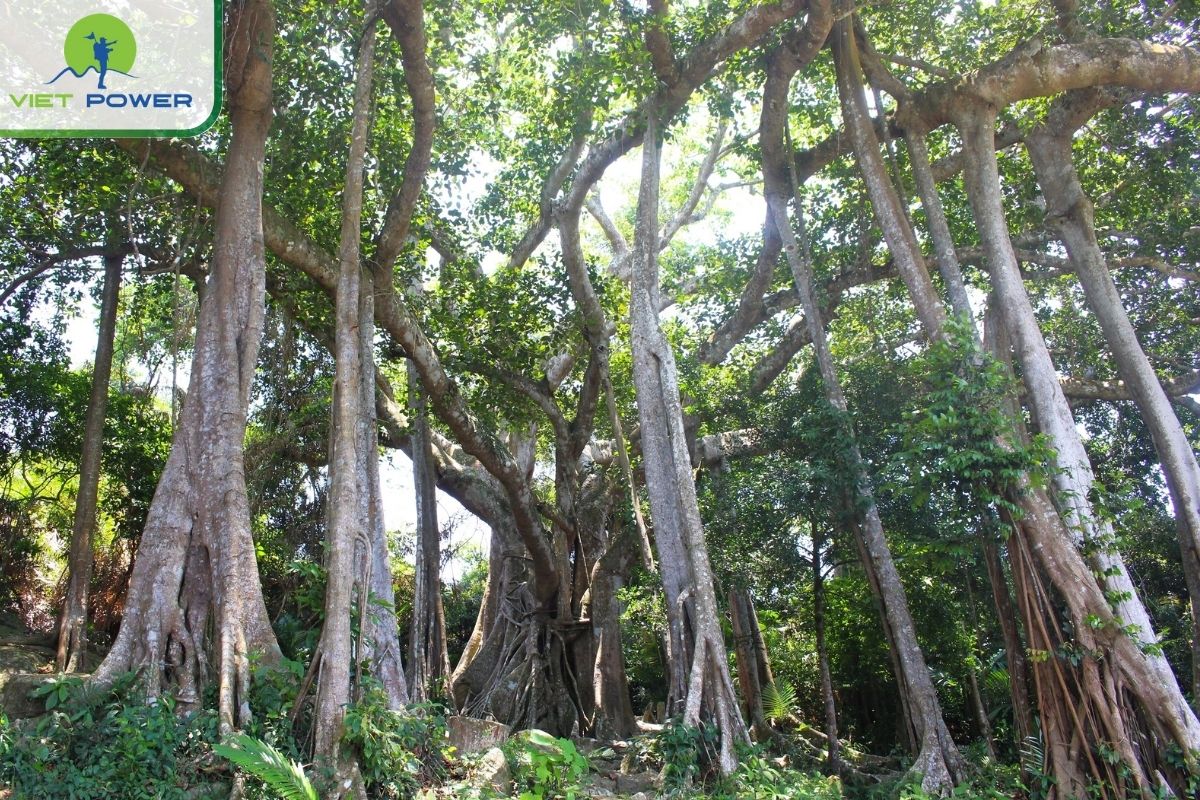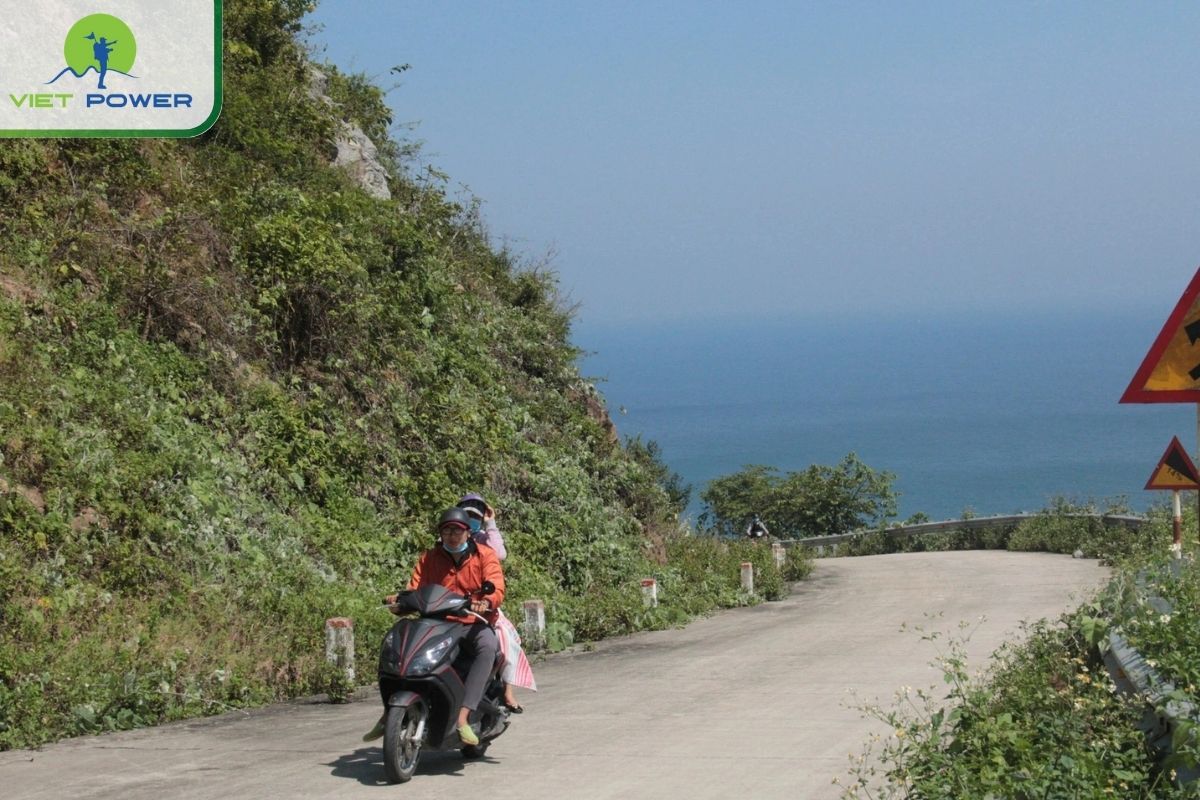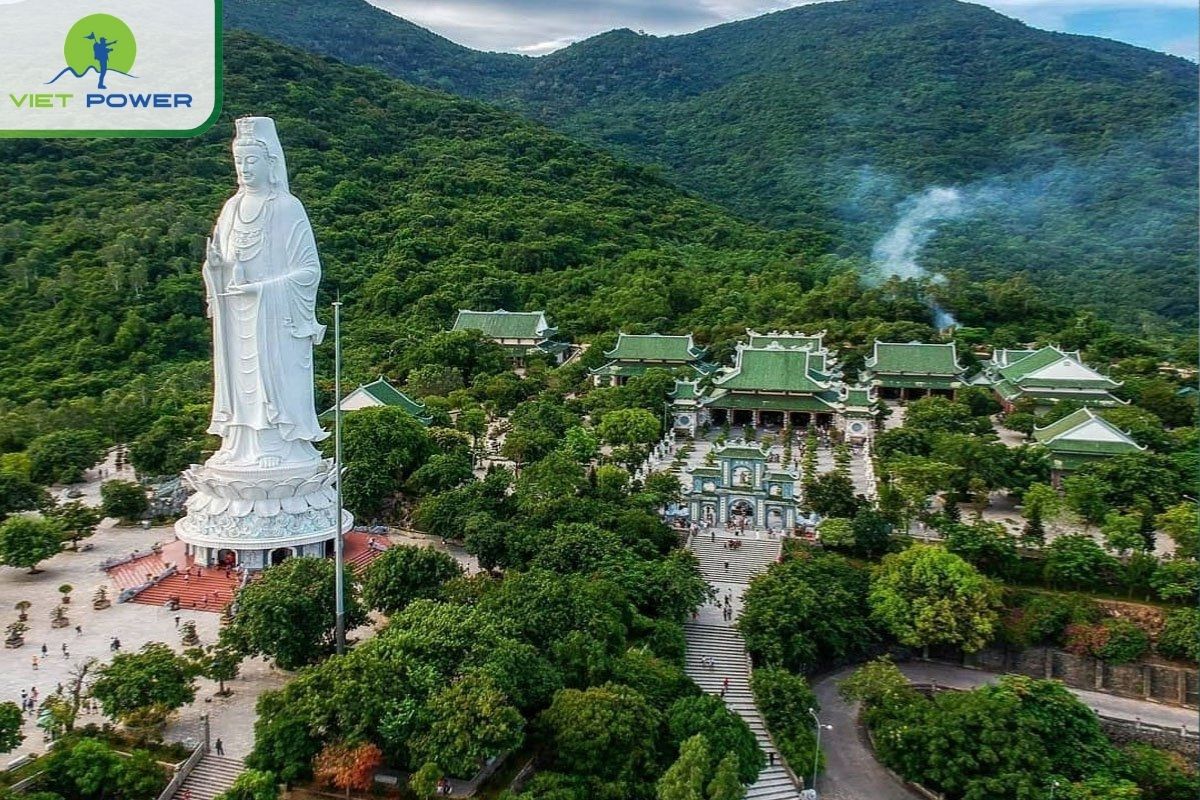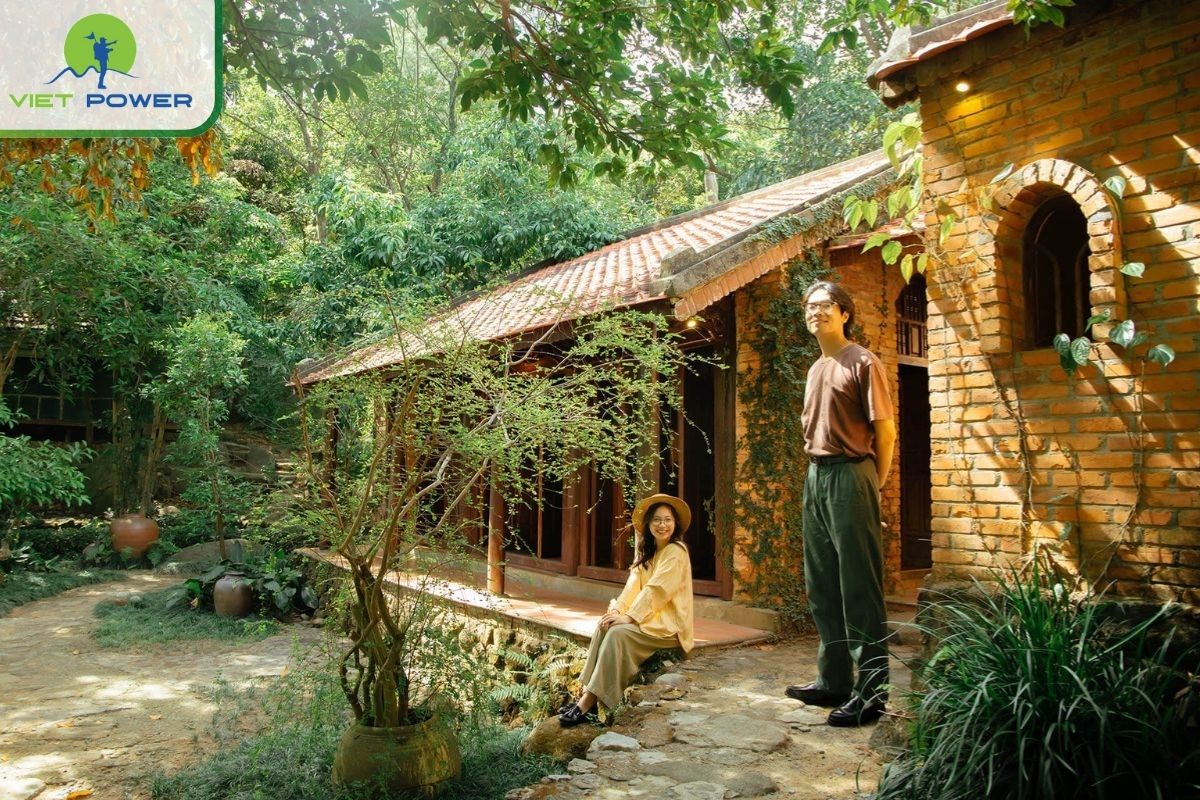Deep in the heart of Son Tra Peninsula, the Banyan Tree Danang rises as a living legend, over 800 years old, with 26 sprawling roots and a canopy shaped by time and myth. More than just a natural monument, it’s a place of heritage, wartime memory, ecological richness, and spiritual belief. From deer-shaped banyans to hidden forest chambers and red-shanked douc langurs, every step unveils a new story. With Vietpower Travel, your journey to this heritage tree becomes an unforgettable eco-cultural adventure through Monkey Mountain Da Nang and beyond.
The Banyan Tree Danang is located within the protected core of the Son Tra Nature Reserve, situated in Tho Quang Ward, Son Tra District, Da Nang City, Vietnam. It stands on the eastern slope of the peninsula, at an elevation of approximately 700 meters above sea level, surrounded by dense tropical forest and dramatic ocean cliffs.
Exact administrative zone: Compartment 62/63 under the forest management system
Road access: Along the Hoang Sa coastal road heading northeast from downtown Da Nang, then diverging at Bai Bac junction onto a narrower forest trail.
Official GPS Coordinates:

There’s always more to see beyond the highlights. Browse our Vietnam tourist attractions category to continue your journey through Vietnam’s must-visit spots.
This remarkable banyan has watched over Son Tra for centuries. First recorded by locals in 1771, the Banyan Tree Danang has seen more than just shifting seasons — it has stood through colonial upheavals, wars, and the transformation of the city around it.
During the resistance against both the French colonial forces and later the American army, the area beneath this giant tree became a refuge for militia members and guerrilla fighters. Its remote location and dense foliage made it a perfect place for planning, sheltering, and exchanging vital intelligence. Even today, standing under its massive trunk evokes the quiet strength of those who once hid here for the future of Vietnam.
This is not just a tree. It is a chapter of history still rooted in place, and one that speaks volumes to those who take the time to listen.
The banyan tree, botanically known as Ficus benghalensis, doesn’t start its life like most trees. In fact, it begins as a guest — a seed sprouting in the crevice of another tree, slowly growing downward with vines that eventually envelop and outgrow their host. This process creates the twisted trunks and open hollows that make banyans so visually captivating.
The Banyan Tree Danang is no exception. Its gnarled base, open archways, and coiling aerial roots are remnants of a fascinating life cycle — one that transformed it from an opportunistic sapling into one of Vietnam’s most revered natural icons. What may have begun as a humble sprout has become a colossal sanctuary for birds, monkeys, and the curious traveler.
From the city center (near Dragon Bridge or Han River Bridge), head northeast along Vo Nguyen Giap Street. This connects directly to Hoang Sa Road — the main coastal road leading to Monkey Mountain Da Nang and the entrance of Son Tra Peninsula.
You’ll ride with the sea on one side and the forested mountain on the other. The views are spectacular, especially around sunrise or early morning.
Continue along Hoang Sa Road for about 10–11 kilometers, passing key landmarks such as:
When you reach Bai Bac junction, keep an eye out for a small paved side road leading into the jungle. There are usually directional signs labeled “Cây Đa Di Sản” (Heritage Banyan Tree).
After the Bai Bac turnoff, you’ll enter a narrow, winding road through the tropical forest. This stretch is about 3–4 kilometers, with several steep slopes and sharp bends. While it is paved, parts of the road can be slippery — especially in wet weather.
Depending on your mode of transport:

Tucked quietly near the main tree lies a unique formation: a banyan whose shape mimics a wild deer. Its trunk splits open into a graceful arch — often described as a “natural gate” — while the upper limbs branch outward like majestic antlers. When sunlight filters through this canopy, the whole scene feels sculpted by the forest itself. It’s one of those moments where the line between myth and biology begins to blur.
(1).jpg)
Walk around the base of the Banyan Tree Danang, and you’ll find roots unlike any other. Some stretch three or four meters away from the trunk, curling across the forest floor in sinuous patterns. Locals liken them to massive serpents — old guardians silently slithering through the soil. The twisting roots create a dramatic contrast to the soft moss and leaf litter beneath your feet.
.jpg)
As you step into the shade of the banyan, you’ll notice something extraordinary. The overlapping roots and thick hanging branches form secluded “rooms” — quiet pockets beneath the canopy where you can sit, reflect, or share a picnic. Each corner offers a slightly different mood. Some are open and breezy; others feel like a treehouse hollowed out by time.
.jpg)
Science backs up what many travelers feel intuitively: spending time beneath ancient trees like this one triggers oxytocin, the same chemical that brings us peace, connection, and emotional comfort. Whether it’s the rhythm of the wind in the leaves or the scent of the forest, there’s something healing about this space. Many visitors say they leave calmer, lighter, like the tree gave them something intangible.
One of the most beloved legends tied to the Banyan Tree Danang says that couples who take wedding photos here will enjoy a love that lasts until “hair turns silver and teeth fall out.” It’s more than a superstition — it’s a charming reason why newlyweds flock here, especially from Da Nang and Hue. With the sprawling roots, soft lighting, and whispering leaves, it’s a deeply symbolic and photogenic setting.
.jpg)
Locals sometimes speak in hushed tones about strange happenings around the tree. A few years ago, a foreign visitor went missing near the site for over two days, only to be found unscathed but disoriented. While explanations lean toward losing signal or misjudging the trails, a layer of folklore still hovers — tales of spirits, enchanted trees, and places where time behaves differently. They’re not stories for fear, but for campfire intrigue.
This isn’t just a scenic stop — it’s part of a protected ecological reserve, and there are specific rules in place to ensure its survival. Visitors must not pick leaves, carve initials, climb branches, or feed wildlife — especially the endangered red-shanked douc langurs who occasionally leap through the upper canopy. These boundaries don’t limit the experience — they elevate it, by asking us to tread gently through something irreplaceable.
Standing 22 meters tall, with a base that stretches 85 meters around and 26 aerial roots reaching down like living pillars, this tree will take your breath away. Walk its perimeter, and you’ll notice how each root tells a different story — some gnarled, some smooth, some wide enough to sit on. At certain angles, it looks like a wooden cathedral sculpted by wind and weather.
.jpg)
The banyan’s dramatic form makes it a dream location for photographers. Whether you're capturing travel memories, engagement portraits, or once-in-a-lifetime wedding shots, this tree delivers a backdrop filled with meaning and mystery. The filtered light beneath its canopy creates a naturally soft glow, perfect for golden-hour magic.
.jpg)
Take a moment to sit beneath the tree, breathe in the salty air, and feel the breeze roll in from the coastline. You’ll hear the creak of distant branches, the occasional chatter of monkeys, and the constant whisper of leaves. Here, nature doesn’t shout — it invites.
.jpg)
You’re welcome to bring a light snack or drink to enjoy in one of the shaded forest nooks. Just be sure to take all your waste with you and avoid feeding the animals. Keeping the area clean ensures others can experience the same tranquility for years to come.
The surrounding forest is alive with color, motion, and song. Keep your eyes open for butterflies, forest birds, squirrels, and — if you’re lucky — the shy red-shanked douc langurs. These rare primates are among the most vividly colored monkeys in Asia and have become an unofficial symbol of Son Tra.
To fully appreciate the wild charm of Banyan Tree Danang, consider linking your visit with a longer jungle loop. Whether you hike or ride, the trails around Monkey Mountain Da Nang lead to panoramic viewpoints, ancient military radar stations, and sea-swept cliffs perfect for meditation or photography. Vietpower Travel offers eco-tours that connect you with these hidden corners — safely and knowledgeably.
.jpg)
Continue exploring similar posts to learn more about Vietnam’s attractions and experiences.
While the route to the tree is scenic, it’s not without its challenges. The winding road climbs steeply with sharp turns and can get slippery, particularly after rain. If you're riding a motorbike, make sure it's well-maintained and preferably manual.
We strongly recommend:
Some stretches of the trail may lack mobile signal, so it's best to inform someone of your itinerary before you set off.
The most enjoyable months are March through September, when dry, sunny weather offers clear skies and firm trails. These months also provide a higher chance of spotting wildlife, especially the elusive red-shanked douc langurs.
To fully enjoy the peaceful atmosphere:
The Banyan Tree Danang is more than a destination — it’s a living archive of Vietnamese culture, nature, and spiritual legacy. Visitors are asked to treat it with the care it deserves.
Please remember:
It’s also highly advisable to visit in small groups, both for safety and for minimizing impact on the environment.
As this area is part of a protected nature reserve, there are no ticket booths, security guards, or rangers permanently stationed at the site. Preparation is key.
Be sure to:
Distance: ~5 km from the banyan tree
What to expect:
.jpg)
Distance: Short hike from the main banyan tree
What to expect:
.jpg)
Distance: About 6–7 km away
What to expect:
.jpg)
Distance: ~10–11 km from the banyan tree
What to expect:

Distance: Just a few minutes from the main road to the banyan
What to expect:

The Banyan Tree Danang isn’t simply old, it’s alive with stories, symbols, and forest spirit. Whether you’re drawn by nature, culture, or healing silence, this tree offers a powerful pause in a fast-moving world. Explore it alongside nearby wonders like Linh Ung Pagoda and Ban Co Peak, guided by the local expertise of Vietpower Travel, your trusted partner in authentic, safe, and soulful journeys across Vietnam.
Uncover the beauty of Vietnam through its famous destinations, from peaceful countryside landscapes to dynamic cityscapes. Wander through ancient towns, majestic mountains, and sparkling bays with Vietpower Travel as your trusted guide. Experience the charm of Vietnam’s attractions in a journey filled with discovery and wonder.